fuel type DODGE DART 2015 PF / 1.G Owners Manual
[x] Cancel search | Manufacturer: DODGE, Model Year: 2015, Model line: DART, Model: DODGE DART 2015 PF / 1.GPages: 664, PDF Size: 16.96 MB
Page 324 of 664
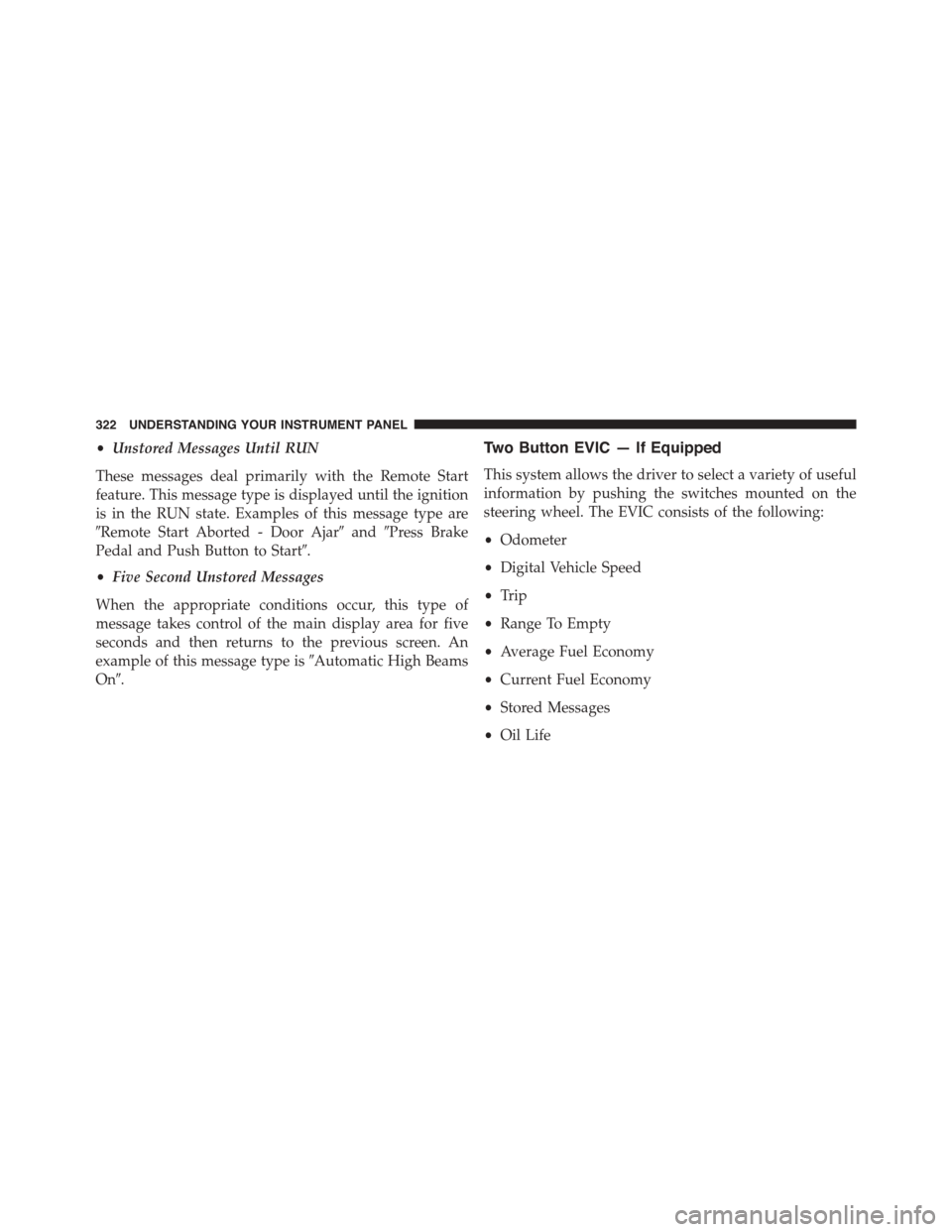
•Unstored Messages Until RUN
These messages deal primarily with the Remote Start
feature. This message type is displayed until the ignition
is in the RUN state. Examples of this message type are
#Remote Start Aborted - Door Ajar#and#Press Brake
Pedal and Push Button to Start#.
•Five Second Unstored Messages
When the appropriate conditions occur, this type of
message takes control of the main display area for five
seconds and then returns to the previous screen. An
example of this message type is#Automatic High Beams
On#.
Two Button EVIC — If Equipped
This system allows the driver to select a variety of useful
information by pushing the switches mounted on the
steering wheel. The EVIC consists of the following:
•Odometer
•Digital Vehicle Speed
•Trip
•Range To Empty
•Average Fuel Economy
•Current Fuel Economy
•Stored Messages
•Oil Life
322 UNDERSTANDING YOUR INSTRUMENT PANEL
Page 335 of 664
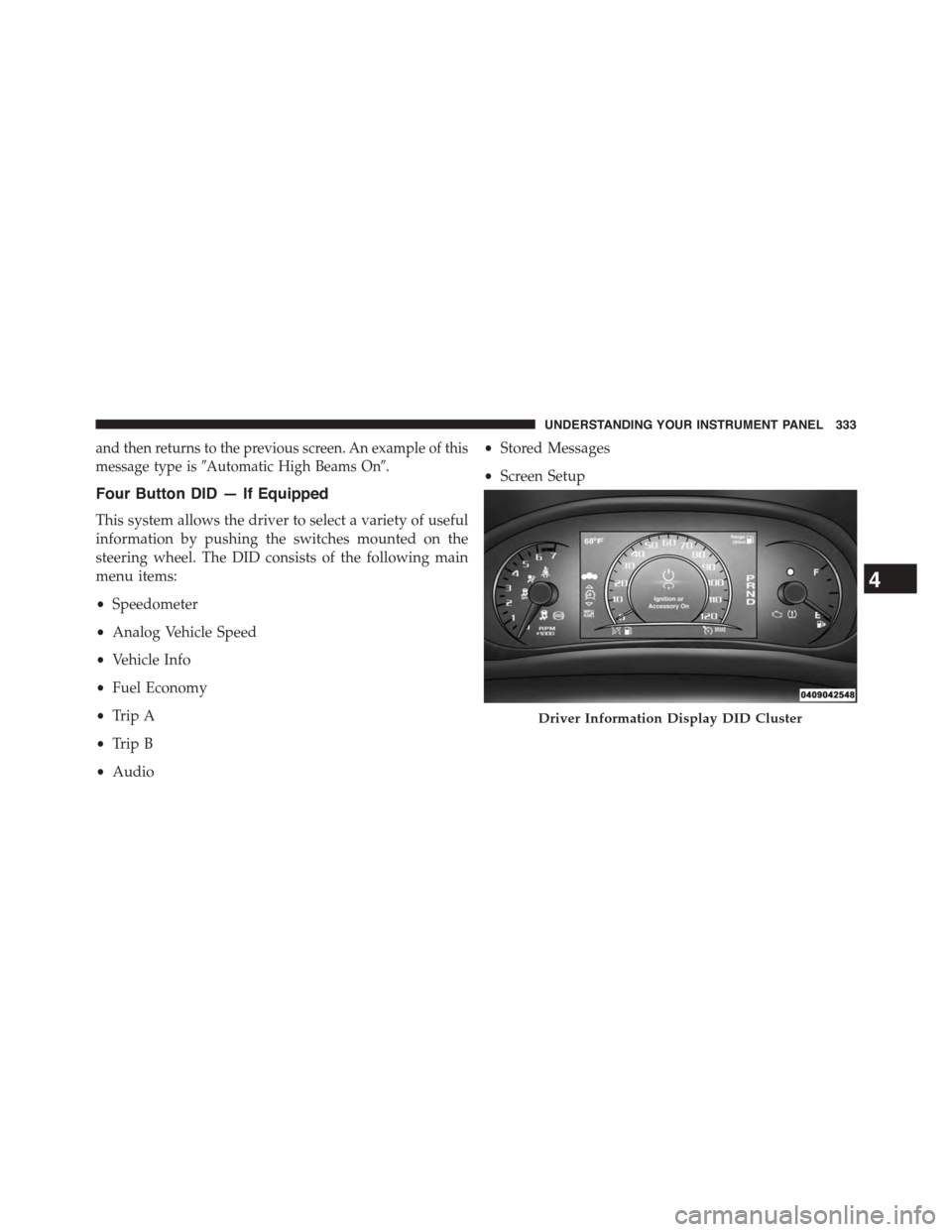
and then returns to the previous screen. An example of this
message type is#Automatic High Beams On#.
Four Button DID — If Equipped
This system allows the driver to select a variety of useful
information by pushing the switches mounted on the
steering wheel. The DID consists of the following main
menu items:
•Speedometer
•Analog Vehicle Speed
•Vehicle Info
•Fuel Economy
•Trip A
•Trip B
•Audio
•Stored Messages
•Screen Setup
Driver Information Display DID Cluster
4
UNDERSTANDING YOUR INSTRUMENT PANEL 333
Page 411 of 664
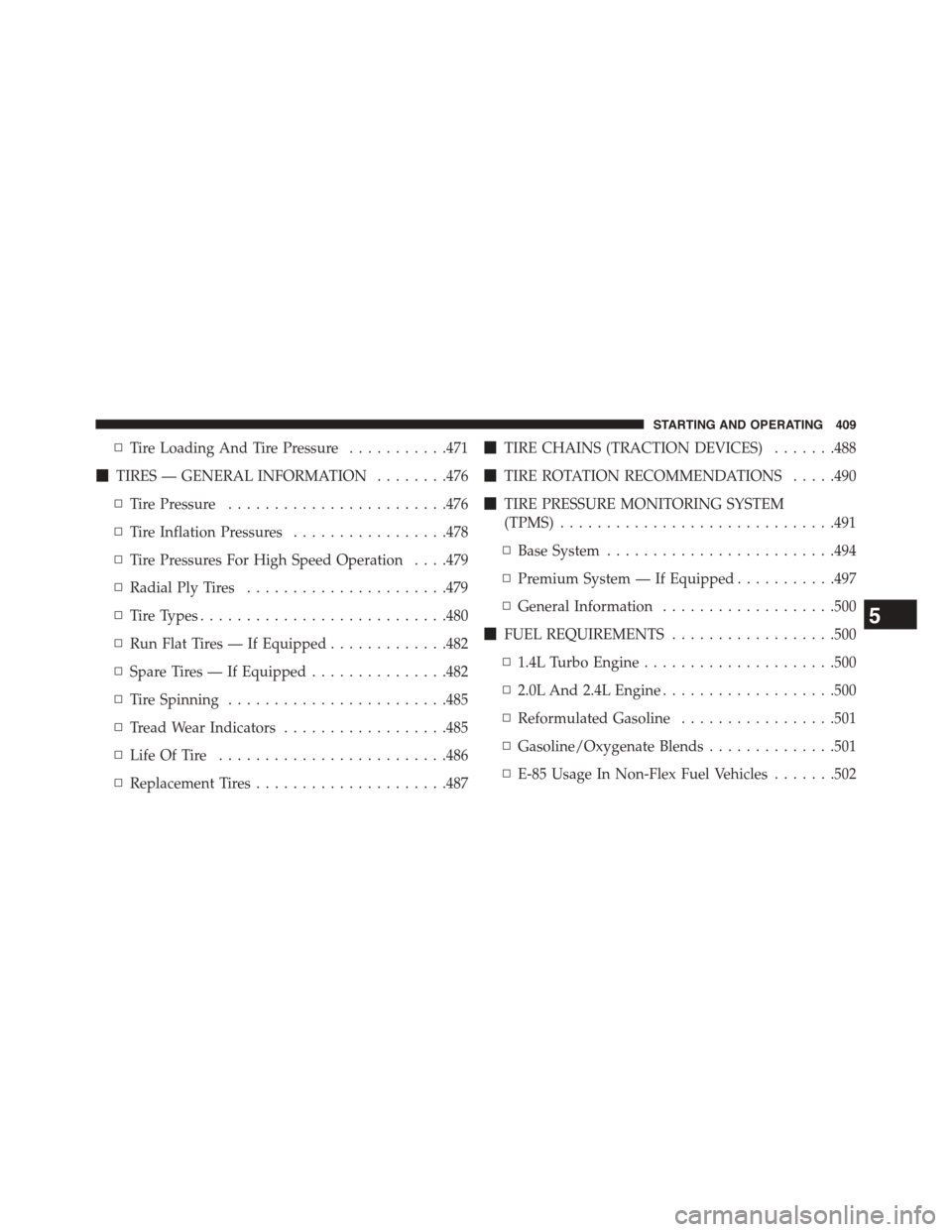
▫Tire Loading And Tire Pressure...........471
!TIRES — GENERAL INFORMATION........476
▫Tire Pressure........................476
▫Tire Inflation Pressures.................478
▫Tire Pressures For High Speed Operation . . . .479
▫Radial Ply Tires......................479
▫Tire Types...........................480
▫Run Flat Tires — If Equipped.............482
▫Spare Tires — If Equipped...............482
▫Tire Spinning........................485
▫Tread Wear Indicators..................485
▫Life Of Tire.........................486
▫Replacement Tires.....................487
!TIRE CHAINS (TRACTION DEVICES).......488
!TIRE ROTATION RECOMMENDATIONS.....490
!TIRE PRESSURE MONITORING SYSTEM
(TPMS)..............................491
▫Base System.........................494
▫Premium System — If Equipped...........497
▫General Information...................500
!FUEL REQUIREMENTS..................500
▫1.4L Turbo Engine.....................500
▫2.0L And 2.4L Engine...................500
▫Reformulated Gasoline.................501
▫Gasoline/Oxygenate Blends..............501
▫E-85 Usage In Non-Flex Fuel Vehicles.......502
5
STARTING AND OPERATING 409
Page 510 of 664
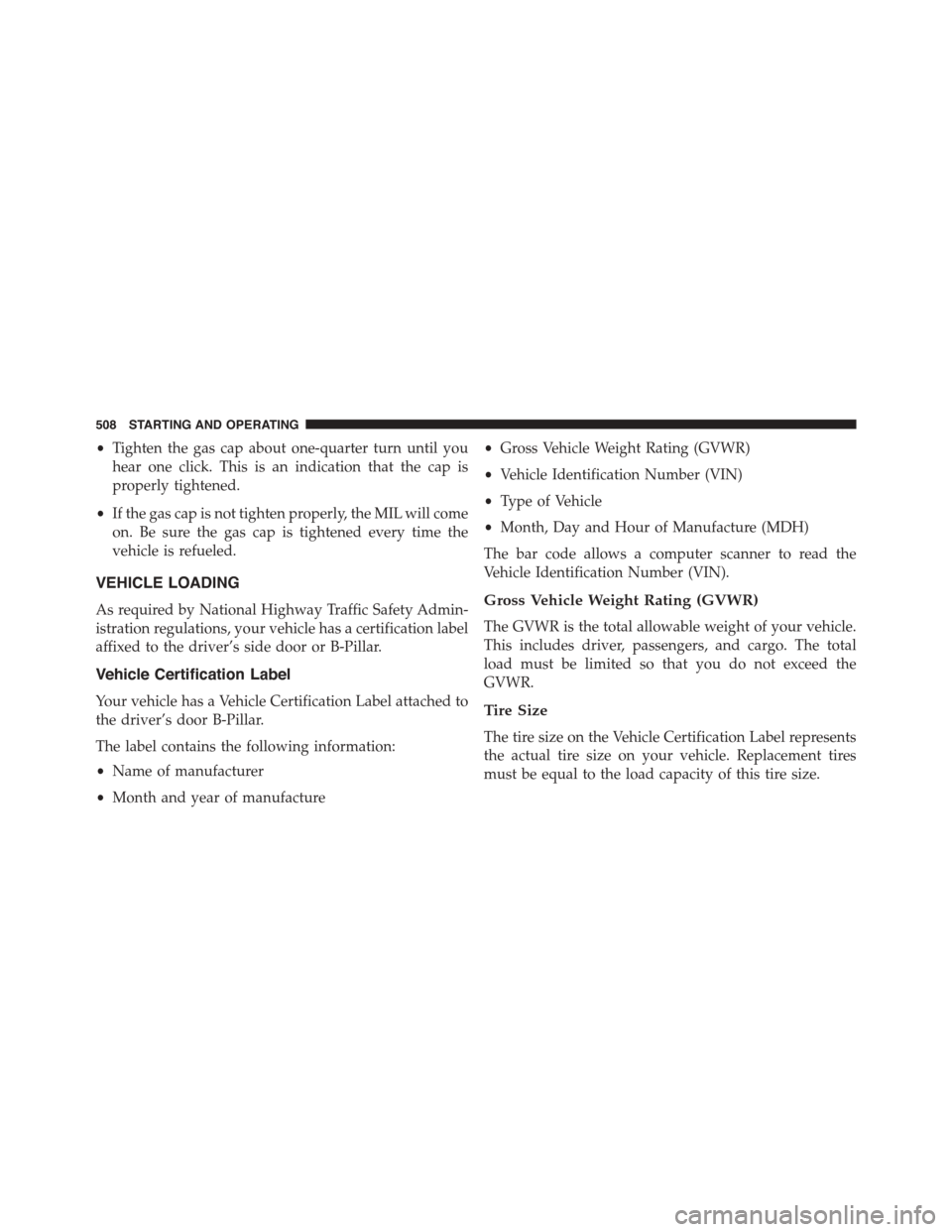
•Tighten the gas cap about one-quarter turn until you
hear one click. This is an indication that the cap is
properly tightened.
•If the gas cap is not tighten properly, the MIL will come
on. Be sure the gas cap is tightened every time the
vehicle is refueled.
VEHICLE LOADING
As required by National Highway Traffic Safety Admin-
istration regulations, your vehicle has a certification label
affixed to the driver’s side door or B-Pillar.
Vehicle Certification Label
Your vehicle has a Vehicle Certification Label attached to
the driver’s door B-Pillar.
The label contains the following information:
•Name of manufacturer
•Month and year of manufacture
•Gross Vehicle Weight Rating (GVWR)
•Vehicle Identification Number (VIN)
•Type of Vehicle
•Month, Day and Hour of Manufacture (MDH)
The bar code allows a computer scanner to read the
Vehicle Identification Number (VIN).
Gross Vehicle Weight Rating (GVWR)
The GVWR is the total allowable weight of your vehicle.
This includes driver, passengers, and cargo. The total
load must be limited so that you do not exceed the
GVWR.
Tire Size
The tire size on the Vehicle Certification Label represents
the actual tire size on your vehicle. Replacement tires
must be equal to the load capacity of this tire size.
508 STARTING AND OPERATING
Page 575 of 664
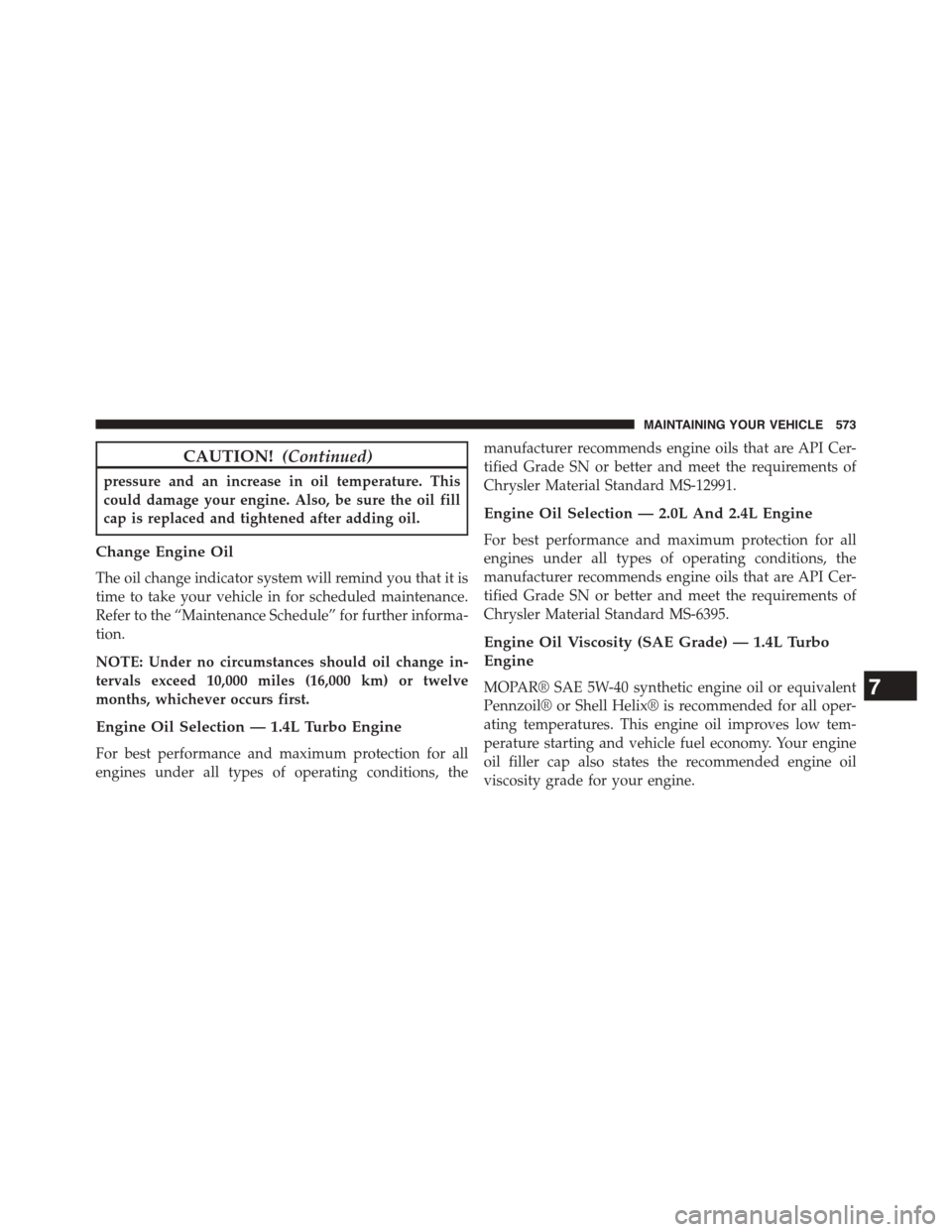
CAUTION!(Continued)
pressure and an increase in oil temperature. This
could damage your engine. Also, be sure the oil fill
cap is replaced and tightened after adding oil.
Change Engine Oil
The oil change indicator system will remind you that it is
time to take your vehicle in for scheduled maintenance.
Refer to the “Maintenance Schedule” for further informa-
tion.
NOTE: Under no circumstances should oil change in-
tervals exceed 10,000 miles (16,000 km) or twelve
months, whichever occurs first.
Engine Oil Selection — 1.4L Turbo Engine
For best performance and maximum protection for all
engines under all types of operating conditions, the
manufacturer recommends engine oils that are API Cer-
tified Grade SN or better and meet the requirements of
Chrysler Material Standard MS-12991.
Engine Oil Selection — 2.0L And 2.4L Engine
For best performance and maximum protection for all
engines under all types of operating conditions, the
manufacturer recommends engine oils that are API Cer-
tified Grade SN or better and meet the requirements of
Chrysler Material Standard MS-6395.
Engine Oil Viscosity (SAE Grade) — 1.4L Turbo
Engine
MOPAR® SAE 5W-40 synthetic engine oil or equivalent
Pennzoil® or Shell Helix® is recommended for all oper-
ating temperatures. This engine oil improves low tem-
perature starting and vehicle fuel economy. Your engine
oil filler cap also states the recommended engine oil
viscosity grade for your engine.
7
MAINTAINING YOUR VEHICLE 573
Page 624 of 664
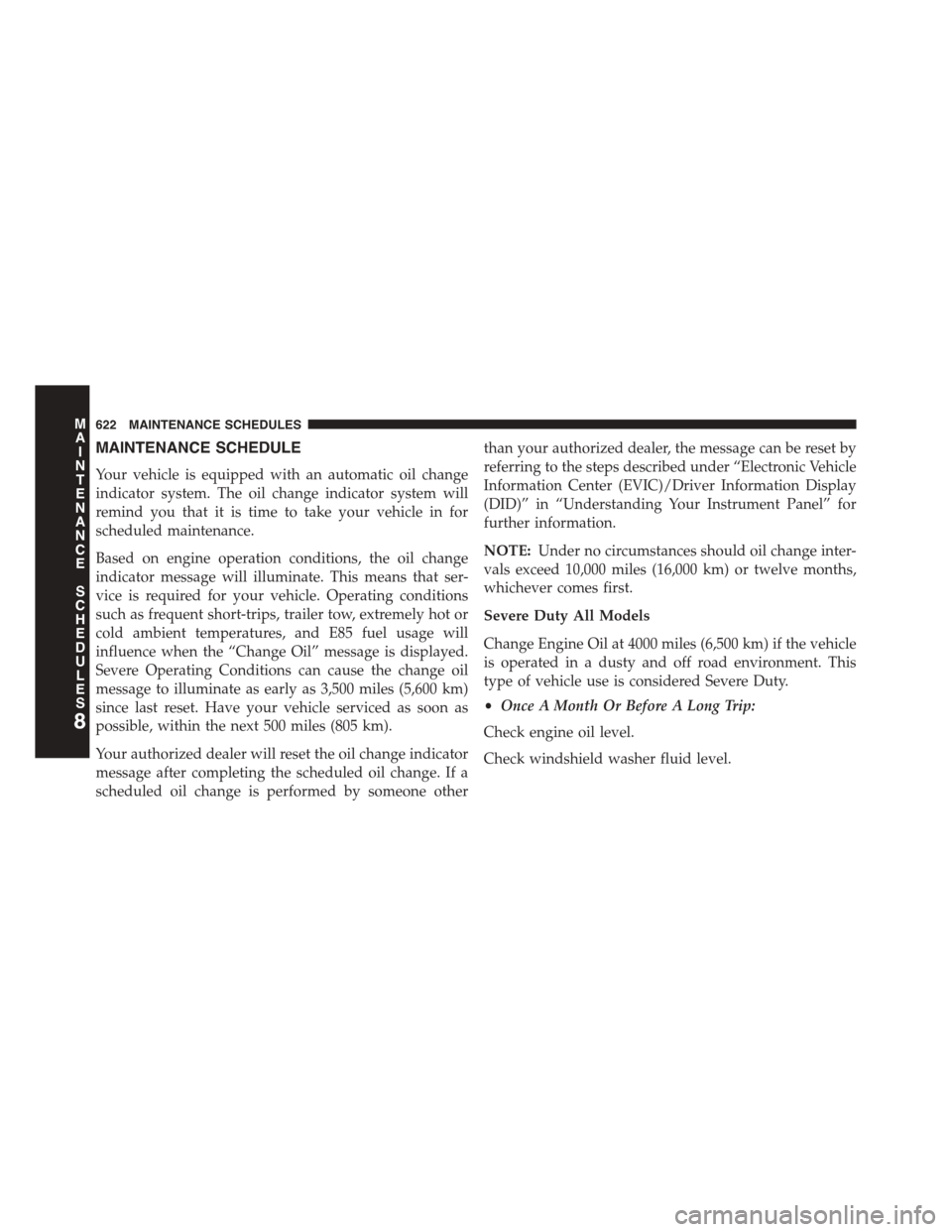
MAINTENANCE SCHEDULE
Your vehicle is equipped with an automatic oil change
indicator system. The oil change indicator system will
remind you that it is time to take your vehicle in for
scheduled maintenance.
Based on engine operation conditions, the oil change
indicator message will illuminate. This means that ser-
vice is required for your vehicle. Operating conditions
such as frequent short-trips, trailer tow, extremely hot or
cold ambient temperatures, and E85 fuel usage will
influence when the “Change Oil” message is displayed.
Severe Operating Conditions can cause the change oil
message to illuminate as early as 3,500 miles (5,600 km)
since last reset. Have your vehicle serviced as soon as
possible, within the next 500 miles (805 km).
Your authorized dealer will reset the oil change indicator
message after completing the scheduled oil change. If a
scheduled oil change is performed by someone other
than your authorized dealer, the message can be reset by
referring to the steps described under “Electronic Vehicle
Information Center (EVIC)/Driver Information Display
(DID)” in “Understanding Your Instrument Panel” for
further information.
NOTE:Under no circumstances should oil change inter-
vals exceed 10,000 miles (16,000 km) or twelve months,
whichever comes first.
Severe Duty All Models
Change Engine Oil at 4000 miles (6,500 km) if the vehicle
is operated in a dusty and off road environment. This
type of vehicle use is considered Severe Duty.
•Once A Month Or Before A Long Trip:
Check engine oil level.
Check windshield washer fluid level.
8
MAINTENANCE
SCHEDULES
622 MAINTENANCE SCHEDULES